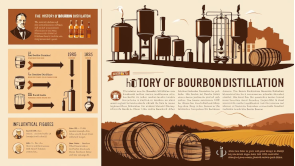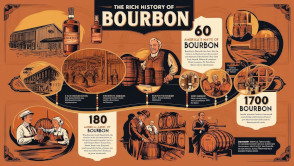
The History of Bourbon Distillation
The history of bourbon is a quintessentially American story, rooted in the traditions of early settlers, the unique geography of Kentucky, and the evolution of distillation practices. Bourbon’s journey from humble beginnings to its status as an iconic spirit is marked by innovation, regulation, and a deep connection to the culture of the United States. Below is an in-depth exploration of bourbon’s history.
Origins of Bourbon
The origins of bourbon trace back to the late 17th and early 18th centuries when European settlers brought distillation techniques to North America. Scots-Irish immigrants, along with Germans and other Europeans, arrived in the American colonies with a rich tradition of producing whiskey from grains like barley and rye. These early distillers applied their skills to the crops available in their new home, leading to the development of American whiskey.
The Role of Corn
Corn, native to the Americas, became a critical ingredient in bourbon production. The fertile soil of Kentucky and surrounding states, combined with an abundance of water, made corn an ideal grain for whiskey distillation. By the late 18th century, corn whiskey had become a staple product of the region.
Whiskey Rebellion and Westward Expansion
The Whiskey Rebellion (1791-1794) was a pivotal moment in American whiskey history. The federal government’s decision to tax distilled spirits led to widespread unrest among farmers and distillers. Many of these distillers, seeking to avoid the tax, moved westward into the frontier territories of Kentucky and Tennessee. In Kentucky, these settlers found ideal conditions for distilling whiskey, and the foundations of bourbon production were laid.
Naming Bourbon
The name “bourbon” is widely believed to be derived from Bourbon County, Kentucky, which in turn was named after the French royal family, the House of Bourbon. While the exact origin of the name is debated, Bourbon County played a key role in the distribution of whiskey during the late 18th and early 19th centuries. Whiskey barrels shipped down the Ohio and Mississippi Rivers were often labeled “Bourbon County,” leading to an association between the name and the distinctive spirit.
The Development of Bourbon as a Distinct Spirit
Charred Barrels
One of bourbon’s defining characteristics—aging in charred oak barrels—may have been discovered by accident. Early distillers often reused barrels that had been charred to sanitize them or to remove flavors from previous uses. Over time, they realized that the charred barrels imparted a rich, caramelized flavor and a golden color to the whiskey. This practice became standard and remains a hallmark of bourbon production today.
The Mash Bill
The mash bill, or the mix of grains used to produce bourbon, became a key factor in defining its identity. By law, bourbon must be made from at least 51% corn, which gives it a sweeter flavor compared to other types of whiskey. The remaining grains typically include rye, barley, or wheat, each contributing unique characteristics to the final product.
Sour Mash Process
The sour mash process, developed in the early 19th century, further refined bourbon production. This technique involves using a portion of mash from a previous distillation to ferment a new batch, ensuring consistency in flavor and quality.
The Rise of Bourbon in the 19th Century
By the mid-1800s, bourbon had emerged as a distinctly American product. Kentucky’s limestone-filtered water, which is rich in minerals, was recognized as an essential ingredient in producing high-quality whiskey. Distillers also began to understand the importance of aging, and many began storing bourbon in warehouses for extended periods, allowing the flavors to mature and deepen.
Early Distillers and Innovations
Several early distillers played crucial roles in shaping the bourbon industry. Elijah Craig, a Baptist minister and distiller, is often credited with introducing charred barrels to the aging process, though this claim remains debated. Other pioneers, such as Evan Williams and Dr. James Crow, contributed innovations in production techniques and quality control.
Transportation and Expansion
The development of transportation networks, including riverboats and railroads, facilitated the growth of the bourbon industry. Barrels of whiskey were transported from Kentucky to markets across the United States, increasing demand and solidifying bourbon’s reputation as a premium spirit.
The Bottled-in-Bond Act of 1897
As bourbon’s popularity grew, so did concerns about quality and authenticity. Unscrupulous producers often adulterated whiskey with harmful additives or diluted it with water. To address these issues, Congress passed the Bottled-in-Bond Act of 1897, the first federal consumer protection law in the United States.
The law established strict guidelines for bourbon production, requiring it to be:
- Aged for at least four years.
- Bottled at 100 proof (50% alcohol by volume).
- Produced at a single distillery in a single distillation season.
- Stored in a federally bonded warehouse.
This act ensured consistent quality and helped establish bourbon as a reliable and trustworthy product.
Bourbon During Prohibition (1920-1933)
The Prohibition era was a challenging time for the bourbon industry. The manufacture, sale, and distribution of alcoholic beverages were banned in the United States, forcing many distilleries to shut down. However, some distilleries were granted licenses to produce bourbon for medicinal purposes. Patients could obtain a prescription for whiskey, which was often marketed as a cure for various ailments. These medicinal sales allowed a few distilleries to survive and maintain production capabilities during Prohibition.
Post-Prohibition and the Bourbon Renaissance
Recovery and Growth
Following the repeal of Prohibition in 1933, the bourbon industry faced a period of rebuilding. Many distilleries reopened, and bourbon regained its status as a popular American spirit. However, competition from other types of liquor, such as vodka and gin, posed challenges in the mid-20th century.
Premiumization and Global Appeal
The late 20th century saw a resurgence in bourbon’s popularity, driven by the rise of premium and small-batch brands. Distilleries began emphasizing craftsmanship, heritage, and quality, attracting both domestic and international consumers. The creation of the Kentucky Bourbon Trail in the late 1990s further boosted tourism and interest in bourbon.
Legal Protection
In 1964, Congress declared bourbon a “distinctive product of the United States,” meaning that only whiskey produced in the United States can be labeled as bourbon. This designation reinforced bourbon’s status as a uniquely American spirit and protected its identity on the global stage.
The Modern Bourbon Industry
Today, bourbon enjoys worldwide acclaim, with Kentucky producing approximately 95% of the world’s supply. The industry has seen an explosion of craft distilleries, offering innovative expressions of bourbon while honoring traditional methods. Distilleries now produce a wide range of products, from classic straight bourbons to experimental blends and finishes.
Sustainability and Innovation
Modern distilleries are increasingly focused on sustainability, adopting practices to reduce waste and conserve resources. Innovations in aging techniques, such as smaller barrels and rapid aging methods, continue to push the boundaries of bourbon production.
Bourbon Tourism
The Kentucky Bourbon Trail has become a major tourist attraction, drawing visitors from around the world to explore historic and modern distilleries. Events like the Kentucky Bourbon Festival celebrate the spirit’s rich heritage and its ongoing evolution.
Conclusion
From its humble beginnings on the American frontier to its current status as a globally recognized spirit, bourbon’s history reflects the ingenuity, resilience, and craftsmanship of its makers. Rooted in tradition yet open to innovation, bourbon continues to captivate enthusiasts and newcomers alike, embodying the spirit of America in every glass.


